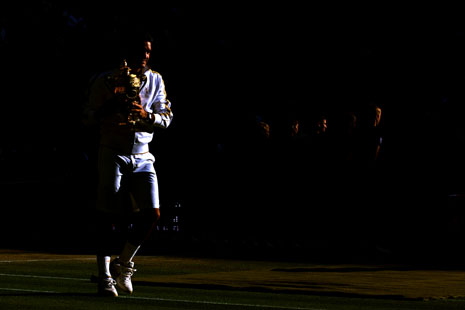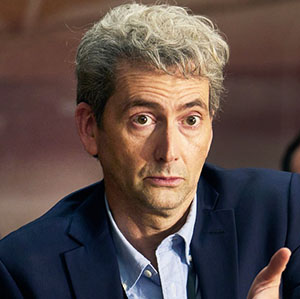ROGER FEDERER might win more Wimbledons but the analogue TV viewers of Mildura will not see them. Next year, they’ll see him in digital or they won’t see him at all.
On 30 June 2010, probably in the middle of one of the Gentlemen’s Singles Quarter-Finals, analogue TV transmissions will cease for households in and around the Murray River town in north-western Victoria.
The moment is termed “digital switchover” or “analogue shutdown,” depending on whether you are excited or traumatised by the prospect. It has been coming since the previous federal government decided to require the commercial networks, the ABC and the SBS to introduce digital TV from 2001.
Each was given a second channel to simulcast in analogue and digital until enough viewers had bought set top converters or integrated digital TVs to receive the digital transmissions. The analogue signals could then be turned off and the frequencies they occupied would be reallocated for other purposes.
The initial switchover deadline was deferred and it will now happen progressively, starting next year and ending in the biggest metropolitan markets in December 2013.
Mildura is going first because it has the biggest take-up of digital TV in the country. Around 70 per cent of households already have access to digital services, much higher than the average of just under 50 per cent across the whole country. Mildura therefore has the smallest proportion of analogue-only households likely to be left with blank screens wondering who made it through to the semi-finals.
Digital TV has been especially popular here and in Tasmania because the third commercial TV network that major cities got in the 1960s was only made available in the last few years, and only on digital.
In some other parts of the world, analogue TV has been switched off already. Berlin, where most people got their television by cable, shut down over-the-air analogue TV transmissions in 2003. The Netherlands and Luxembourg shut down in 2006 and Sweden in 2007.
Then on 12 June this year, the biggest TV market in the OECD, the United States, switched off completely. This step, more than any other, showed that digital switchover is not just a clever-sounding, big picture aspiration for policy wonks, or a side issue for small countries with mainly cable TV. It decisively shifted the policy debate elsewhere, from what digital TV could provide to what else might be done with the vacated analogue spectrum.
In the United States, most of it was acquired at auction by the big telecommunications companies, Verizon and AT&T. They are planning to use it to expand mobile broadband services greatly, offering much faster access speeds to people with laptops and mobile handheld devices like iPhones, Blackberries and the new Nokias.
In Australia, the fight for the spectrum that will become available after 2013 is moving quickly.
On one side are the local mobile phone companies, Telstra, Singtel/Optus and the newly merged Vodafone/Hutchison. For them, the future is broadband and the broadband future is increasingly mobile. A fifth of Australia’s broadband subscribers are already mobile wireless subscribers. More are signing up for mobile broadband and they want faster access speeds to download more data more quickly.
On New Year’s Eve last year, sixty-four million text messages were sent by Telstra’s customers, around four times the number sent five years earlier, according to the company’s acting executive director of regulatory affairs, Jane van Beelen. But SMS is now less than half the mobile data story. In 2008, for the first time, Telstra earned more revenue from other mobile data applications than from SMS. These include email, downloading and uploading photos, music and videoclips, and accessing social networking sites like Facebook, which now counts more than one in four Australians as a member.
Growth like this, say the phone companies, means they need more spectrum to keep up, although the broadcasters complain they are not using all the spectrum they already have. The particular frequencies being vacated when analogue TV shuts down are especially attractive. Signals travel a relatively long way and penetrate inside buildings – the same reasons TV broadcasters like them.
TV broadcasters acknowledge the growth in mobile broadband but they disagree about how much spectrum will be freed up when they turn off their analogue signals – the so-called “digital dividend.” They also disagree about what should be done with it, because they have plans of their own.
The size of the digital dividend depends on how comprehensively we want digital TV services to replicate the coverage of analogue TV. It also depends on the extent to which we are prepared to change the frequencies now used by some broadcasters for their digital services, to achieve more efficient use of spectrum – a process known as “restacking.”
We can leave some people who are now able to watch over-the-air analogue TV to get digital TV only by satellite or perhaps the new, fibre National Broadband Network. That would mean fewer frequencies would need to be used for digital TV and more could be made available for mobile broadband and other purposes.
But this would require consumers to have more complex and expensive TV receiving equipment and internal connections, and perhaps pay ongoing subscriptions. Even if they do that, the domestic satellite currently doesn’t carry all the dozens of local TV services offered in every market. The national broadband network has not even started and won’t be finished for eight years, although the proposed early start in Tasmania might mean there’s infrastructure in place in time there to help the digital switchover planned for the first half of 2013, as well as fill in some mainland metropolitan reception black-spots.
So forcing some viewers into satellite or fibre reception is unlikely to be popular with those who have got used to the simplicity of buying a TV, plugging it in, turning it on and watching signals from a nearby, over-the-air transmitter. Restacking is also potentially disruptive to viewers in some areas who may need new aerials.
Neither is likely to be popular with the politicians who represent the electorates where these people live.
The gains from more efficient use of spectrum, however, might be considerable. A lot of frequencies are used to reach only small numbers of people across Australia’s sparsely settled country areas or in pockets of bad reception in cities. The ABC, for example, reaches 92 per cent of the population with 50 per cent of its transmitters and only an extra 6 per cent with the remaining 50 per cent of its transmitters. A large amount of spectrum could be reallocated for other purposes if a little less of the population got its television over-the-air.
Any digital dividend won’t be reaped until after 2013, but the big decisions need to happen much earlier than that. Any inconvenience to viewers will be minimised if “restacking” occurs at the same time as analogue TV is switched off, region by region. That means the whole national plan for spectrum allocations that will apply after 2013 really needs to be settled well before the first market, Mildura, switches off in the middle of next year. The government has promised a green paper, but they have very little time to colour it white.
WILL TV or mobile broadband and other wireless services matter more to people after 2013? Or will it be something else altogether, given the uncertainty about future technology developments? In the United States, more than a fifth of the vacated spectrum has been allocated for public safety purposes, to remedy deficiencies exposed by the 9/11 terrorist attacks and Hurricane Katrina in the communications systems used by firefighters, police and ambulance services.
TV broadcasters, not surprisingly, think TV will still matter a lot. They have plans for more services of their own, beyond the new ones they have already introduced – ABC-2, SBS-2 and the Ten Network’s OneHD sports channel. Generally, they are being quiet about the detail, but ABC managing director Mark Scott made clear at a Network Insight seminar in Sydney on 8 July that he would like to be able to offer a news and public affairs channel – a twenty-four hour version of the ABC News Breakfast show launched recently on ABC-2.
He makes the same argument as the corporation did, successfully, for the government to fund ABC-3, the new, free-to-air children’s TV channel that will be on air in December: “If there are going to be fifteen channels in this new free-to-air landscape, shouldn’t there be one channel for Australian children?”
Former Queensland premier Wayne Goss, the head of Free TV Australia, the organisation representing Australia’s commercial TV stations, emphasises free-to-air TV’s vital role as a producer of Australian programs and host of the country’s “common conversation.” A medium that still pulls audiences of over a million people to programs every night of the week generates a lot of talk. A significant amount of broadband use is actually a kind of TV, catching-up on programs or highlights of them.
TV broadcasters generally stress the scale of the engineering and consumer awareness challenge ahead in switching off analogue TV and the risks to good quality digital reception if the more aggressive restacking proposals are adopted. Although there are now more mobile phone services than people in Australia, each household still has an average of 2.2 TV sets. No one doubts the political perils for a government that has to take the blame for turning some of them black and silent. It was no accident that shutdown in the United States was initially scheduled for February this year, three months after a presidential election and a few weeks after the Super Bowl.
The phone companies and pay TV operators think the broadcasters are making too much of the complexities. They’ve done switch-offs themselves, including the analogue AMPS and CDMA mobile phone networks. Foxtel converted all its analogue pay TV customers to digital. Britain, where television started much earlier than Australia, switched off the 405-line transmission system it used for its first, pre-war service. As digital switchover progresses around the world, service providers and perhaps consumers as well will increasingly ask not why it should occur in Australia, but why it hasn’t.
While these other switch-offs prove it is possible, they also demonstrate how contentious it can be. Australia’s one experience with switching off a television service was a long way away from metropolitan media interest, but extremely controversial for those affected. These were the remote area viewers who had to replace their satellite receiving equipment when a new satellite took over from the one that had been transmitting their TV services for several years.
When the policy about digital TV was first considered in the mid-1990s, TV was the colossus of popular media and the people who ran it were giants in the political process. Mobile telephony was growing fast but the internet was only just beginning to hit public and political consciousness. The iMac was not yet launched and the iPod was years away, let alone the iPhone.
Nearly fifteen years on, the government is more excited about the $43 billion it is spending on a national broadband network. It is also going to be a major investor in this network with a direct financial interest in how it gets used. TV is not the medium and TV broadcasters are not the people they were.
Their audiences remain large and politicians still care a lot about the nightly TV news and live free-to-air coverage of major sporting events, but audiences for most regular programs have been in gentle decline for a long time. After foreign ownership limits were abolished in 2006, an overseas private equity firm took over the Nine Network, the ailing Canadian CanWest took full control of the Ten Network and another overseas private equity firm took a half share in the top-rating Seven Network. Kerry Packer, such a dominant influence in media policy under successive governments, is no longer around.
Almost everyone has a mobile phone and many have more than one. A new study appears almost every day celebrating the “digital natives” who say they never watch TV. By 2013, there’ll probably be a few in cabinet. It is hard to avoid the conclusion that mobile media already matters at least as much to many people as television, although tastes vary greatly across different age groups and predicting what “mobile media” and “television” might be in 2014 is a fraught exercise.
The size of the “digital dividend” and what should be done with it are where the two collide. In public there’s a lot of soft talk about win–win outcomes and the need for balance. Wayne Goss told the Network Insight seminar, “it’s not ‘either/or’ but ‘either and or.’”
Away from the conferences, where the engineering rubber hits the political road, the talk is going to get a whole lot tougher. •




